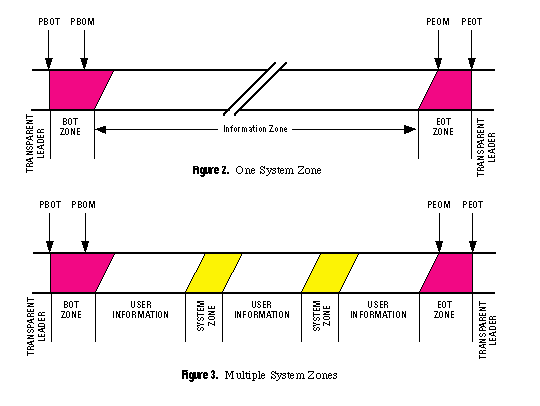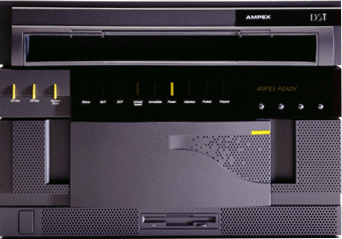|
|
Ampex changes rules for high-end tape backupNew technology, higher capacity make serial tape backup a thing of the past. How Ampex's new Legato NetWorker support fits into Sun's enterprise storage scheme |
|
Mail this article to a friend |
Redwood City, CA (02/06/97) -- Ampex Corp. increased its high-end support for Sun's enterprise efforts by adding Legato Systems NetWorker 4.2.5 enterprise storage management software support to its DST 19mm tape drives and automated cartridge libraries (ATL). Ampex also plans to double the capacity of its high-end storage line, which will now top out at 330 gigabytes on a single cartridge, later this spring. The effort follows Sun's recent announcement that it plans to move further into the high-end Unix server market.
Just last month, Sun and Legato expanded their plans to integrate Legato Systems' NetWorker technology into the Sun Enterprise Storage Manager product (see SunWorld's story in Resources below). Sun also announced its intent to begin shipping Solstice Backup release 4.2.6 and Solstice Backup Database Module for SAP R/3 within the current quarter. Solstice Backup technology is licensed from Legato.
NetWorker's features include the ability to send parallel data streams simultaneously from multiple clients to multiple backup devices, enterprise-class media management for automation of all media handling tasks, autochanger support for "hands-off" automation, consistent approach to local, centralized, or remote administration, and support for online database and application backup.
On the hardware side, Ampex's Michael Wilke, senior director of business development, says the company is just now starting to exploit the DST drive's helical scan technology. The doubling of the drives' capacity was achieved by recording tracks closer together, but Wilke says several new approaches will allow Ampex to achieve even greater capacity and related performance gains.
One new capability of the DST family is a dramatic change from traditional tape backup approaches that can provide IT managers with significant flexibility in backing up systems. The drive now allows the IT manager to create logical partitions on the tape, an approach not unlike creating logical partitions on disk drives -- but data accesses within the partition are still serial and not random access.
A 25-gigabyte tape, for example, could be partitioned into five 5-gigabyte partitions, one for each member of a small department. Instead of each user recording their data to the tape serially, each user can record to a predefined partition, so that periodic updates to the tape can be kept in a single, contiguous portion of the tape. It will be unnecessary for the drive to seek and record all over the tape; instead, it will just pick up where it left off or users can choose to replace their own data.

This approach allows the IS manager to back up individual users' disk drives, departmental servers, enterprise storage subsystems, or even individual storage arrays. When the tape drive is streaming, it is rated to back up in excess of 50 gigabytes per hour.
Three new models are expected to begin shipping in volume during the second quarter: the DST 312 drive, the DST 412 Tape library, and the DST 812 Tape Library. The smaller library supports one drive, up 2.4 terabytes, and can transfer data up to 15 megabytes per second. The 812 library supports up to 12.8 terabytes and up to four drives. Target markets include networks with more than 100 gigabytes of centralized databases, networked storage of large multimedia objects, and high-speed collection or transfers of large data sets.

Wilke notes that the tape drive can access any point on the tape in less than 25 seconds on average. While this still isn't equal to direct-access speeds of magnetic or optical disks, it far surpasses traditional tape speeds. For very large installations, he says, a single 19mm DST drive far outperforms the fastest alternative tape option, which would be multiple digital audio tape (DAT) drives and a correspondingly high number of DAT cartridges.
Three cartridges are available for the drives: 25 gigabytes/50 gigabytes, 75 gigabytes/150 gigabytes; and 165 gigabytes/330 gigabytes. The drives will accept any of the cartridges, although the largest tape library only accepts the smallest cartridge; this limitation is not in the drive itself, but in the loading mechanism, since the company believes that if an IS manager is using the large tape library, then the storage requirements are very large as well.
Currently, Ampex provides drivers for Sun Microsystems Solaris, Silicon Graphics Irix, Hewlett-Packard HP-UX, IBM AIX, Digital Unix, and other Unix implementations.
In the near future, Wilke expects tape technology to double again to quad density, increasing tape capacity to 660 gigabytes and transferring data at up to 30 megabytes per second. By early 1999, he expects tape thickness to be reduced, allowing more tape per cartridge, high linear densities, and high track densities. At that point, he says, the drive will need to employ a new interface, such as fibre channel, to support data transfer rates of up to 40 megabytes per second.
By the turn of the century, Wilke expects Fortune 500 companies to have storage requirements ranging up to the hundreds of terabytes, amounts unheard of for commercial applications just a few years ago.
--Stephen Lawton
|
|
Resources
If you have technical problems with this magazine, contact webmaster@sunworld.com
URL: http://www.sunworld.com/swol-02-1997/swol-02-ampex.html
Last modified: